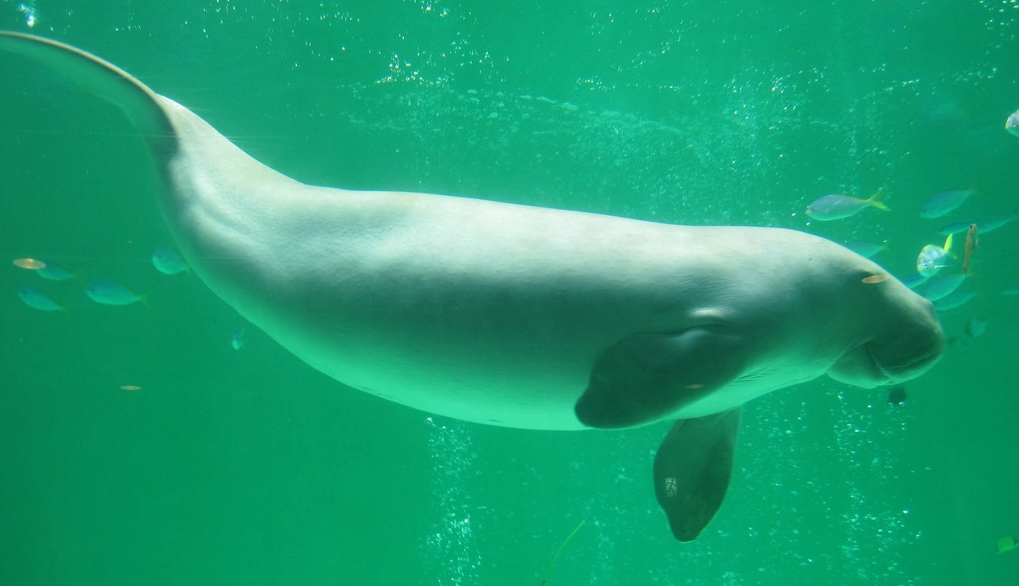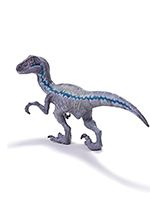Home > Company News > Let's protect the endangered animal-Dugong dugon
Company News

Dugong dugon, some people called it as mermaid, is a marine herbivorous mammal. The body of the dugong is fusiform, about 3 meters long and weighing 300-500 kg. There are sparse short hairs all over the body. There is no obvious neck, the head is small, the upper lip resembles a horseshoe shape, the snout is protruding with bristles, and two approximately circular breathing holes are juxtaposed at the top of the head; there is no outer auricle, and the ear holes are located behind the eyes. There is no dorsal fin, and the flippers are oval. The tail fin is wide, flat and symmetrical on the left and right sides, and the trailing edge is crescent-shaped without notches. There are a pair of breasts below the flippers. The back is mainly dark gray, and the abdomen is slightly lighter. It mainly lives in shallow tropical seas and feeds mainly on aquatic plants such as two-drug algae and salt-loving grass. Its distribution is closely related to water temperature, ocean currents and the distribution of seaweed as the main food.
 Dugongs are mainly distributed in Guangdong, Guangxi, Hainan and the southern coast of Taiwan in China. Because it needs to surface regularly to breathe, it is often referred to as a âmermaid.â The dugong is one of the oldest marine animals in the world. It is a national first-class protected animal in China and one of the endangered species. Since four thousand years ago, humans have begun hunting dugongs, eating meat and pressing oil, bones can be carved, skins can be tanned, and dugongs have been extremely rare. In 1996, the Guangxi National Dugong Nature Reserve was established in the coastal waters between Yingluo and Dafengjiangkou in Beihai, Guangxi.
Dugongs are mainly distributed in Guangdong, Guangxi, Hainan and the southern coast of Taiwan in China. Because it needs to surface regularly to breathe, it is often referred to as a âmermaid.â The dugong is one of the oldest marine animals in the world. It is a national first-class protected animal in China and one of the endangered species. Since four thousand years ago, humans have begun hunting dugongs, eating meat and pressing oil, bones can be carved, skins can be tanned, and dugongs have been extremely rare. In 1996, the Guangxi National Dugong Nature Reserve was established in the coastal waters between Yingluo and Dafengjiangkou in Beihai, Guangxi.
Making animal figures is our business however we also care deeply about nature and conservation. To that end we worked with the Guangxi Academy of Sciences & National Laboratory of Offshore Marine Environmental Science. Whilst it is fair to say we only play a very small part in this process, it is something we believe in and are happy to be involved and we can move further.
For more information on the National Laboratory and our Dugong Dugon Figure please check: http://english.ihb.cas.cn/
-
MEOW LOVE Corrugated Cardboard Cat Scratcher Sofa Protector Stocked Cat Toy and Bed for Cats Paper Scratch Board
-
MEOW LOVE New Pet Toys Corrugated Paper Material Wear Resistant Cat Scratch Board Double Storey Cat House Pet Products
-
MEOW LOVE Cat Scraper Board Side Cat Scraper Pad After Cat Scraper Design Triangle
-
MEOW LOVE Wear-Resistant Cat Paw Grinder Pet Cat Scratcher Corrugated Cardboard Scratch Pad Wood Corrugated Paper Toy Durable Cat Carton
-
MEOW LOVE Cat Scraper Board Side Cat Scraper Pad After Cat Scraper Design Triangle
-
Meow Love All-in-one Eco-friendly Warm Pet Bed Multifunctional Cat Toy Nest Cat Tunnel Runway Play Sleep
-
MEOW LOVE Double Deck Cat Home Cat Scratching Board Wooden Pet Supplies Foldable Cat House
-
Meow Love Indoor Coral Fleece Cat Shelter with Heated Pet Pad Easy-to-Assemble Breathable Safe Winter Housing for Cats
-
Meow Love Dog Chew Toys Dog Toothbrush Stick Teeth Cleaning Brush Outdoor Dog Squeaky Toys for Aggressive Chewers Tough Toys Interactive
-
Meow Love Dog Toys Pet Gnawing Grinding Teeth Rugby Bite Resistant Not Bad, Thorn Ball Puzzle Rubber Food Leakage Ball Supplies
-
Meow Love Soft Indoor Pet Rest Sleeping Bed Sofa Round Donut Cat Bed Calming Washable Plush Dog Bed
-
MEOW LOVE Custom 24 Inch Cat Scratcher Cardboard Sofa Extra Large Size Cat Scratcher for Indoor Cats
-
Meow Love Fall/Winter Pet Mat Soft Removable Washable Rose Velvet Nest for Cats & Big Dogs Anti-Bite Dog Bed with Foam Cushion
-
Meow Love Plush warm dog mat four seasons comfortable large dog mattress can be removed and washed sponge pet sofa cushion cat litter
-
Meow Love Soft Flannel Thickened Pet Soft Fleece Pad Pet Blanket Bed Mat for Puppy Dog Cat Sofa Cushion Home Rug Keep Warm Sleeping Cover
-
Meow Love Desk wooden cat may desk bed with 360 degree rotating metal raised mount and comfortable soft plush pet mat
-
Meow Love Plush warm dog mat four seasons comfortable large dog mattress can be removed and washed sponge pet sofa cushion cat litter
-
Meow Love Large Cat Nest Washable Winter Sleeping Bag with Breathable Feature for Small Animals Made of Foam Felt and PP Material
-
MEOW LOVE Foldable Pet Stairs Integrated Storage Easy Access Neat Organization Cats Staircase Space-Saving Dogs Steps
-
MEOW LOVE Newly designed OEM ODM custom logo Animal style sisal Round Cat scratch toy bed
-
Meow Love New cute style enclosed removable and washable cat house pet bed
-
MEOW LOVE 2 Sets of Cat Corrugated Cardboard Multi-Shape Design With Catnip Combination No Scraps Can Be Customized Patterns
-
MEOW LOVE Multi-functional dog nail care tool Large dog scraper treatment drawer for easy nail sharpening scissors Pet bowl feeder
-
Meow Love High Quality Foldable Cat Scratcher House Covered Kitty Cave Beds Cute Modern Cat Condo for Indoor Cube House
Popular Searches
- soft plastic farm animal toy
- animatronic toy animal
- jurassic park toys
- lovely horse pony
- plastic horse toy
- dinosaur lays eggs
- dig dinosaur fossil toys
- animal kingdom toy
- animal set toys
- animated animal model
- assembling dinosaur toy
- animation motors for toys
- anim models
- animated dinosaur toys
- animated dinosaur toy
- b o dinosaur toy


